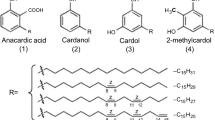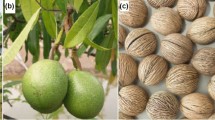Abstract
In recent times, attempts have been made to produce eco-friendly sound exceptional resin compounds from natural renewable resources. Among the diverse renewable available sources, vegetable oils obtained from various seeds are considered the best natural sources, due to their novel characteristics, worldwide abundance and functionalities. However, the alkyd resins synthesized from available vegetable oils are still limited in properties. This review focused on the several modification routes that have been utilized in the synthesis of solvents and water based alkyd resins, the impacts on their coating properties and challenges of using alkyd coatings. Literature analysis reveals that modifications of solvents based alkyd resins and water-borne alkyd resins have immensely improved their potential applications in the field of paints and coatings. Properties like adhesion, drying time, gloss retention, resistance to scratch, chemical resistance capability in various corrosive environments, thermal stability, flexibility, roughness, hardness, abrasion resistance, mechanical properties, etc., were improved by modifying solvent based alkyd resin and water based alkyd resin with gum rosin, acrylate, n-butyl methacrylate, maleican hydride, silicon oxide (SiO2), titanium oxide (TiO2), etc. Also, waterborne coatings have been shown to be a more environmentally friendly coating when compared to solvent based coatings. However, water based alkyd resin is more eco-friendly than the solvent based alkyd resin; as a consequence, they emit little or no contaminant that can be detrimental to the environment.









Similar content being viewed by others
References
Ifijen HI, Nkwor AN (2020) Selected under-exploited plant oils in nigeria: a correlative study of their physiochemical properties. Tanzania J Sci 46(3):817–827
Ifijen IH, Odi HD, Maliki M, Omorogbe SO, Aigbodion AI, Ikhuoria EU (2020) Correlative studies on the properties of rubber seed and soybean oil based-alkyd resins and their blends. J Coat Technol Res 18(5):459–467. https://doi.org/10.1007/s11998-020-00416-2
Malik M, Ikhuoria EU, Ifijen IH (2020) Extraction and physiochemical characterization of oils obtained from selected under-utilized oil bearing seeds in Nigeria. ChemSearch J 11(1):110–117
Maliki M, Ifijen IH (2020) Extraction and characterization of rubber seed oil. Int J Sci Eng Sci 4(6):24–27
Nkwor AN, Ukoha PO, Ifijen HI, Ikhuoria EU (2020) The use of sulfonated Jatropha curcas oil for the processing of mechanically improved leather. Chem Afr 3:911–925. https://doi.org/10.1007/s42250-020-00189-6
Samarth NB, Mahanwar PA (2015) Modified vegetable oil based additives as a future polymeric material—review. Open J Org Polym Mater 5:1–22. https://doi.org/10.4236/ojopm.2015.51001
Islam MR, Beg MDH, Jamari SS (2014) Alkyd based resin from non-drying oil. Proc Eng 90:78–88. https://doi.org/10.1016/j.proeng.2014.11.818
Islam MR, Beg MDH (2018) Dispersion characteristics of hydroxyl and carboxyl-functionalized multi-walled carbon nanotubes in polyester nanocomposites. J Polym Eng 38(8):759–765. https://doi.org/10.1515/polyeng-2017-0363
Lligadas G, RondaJ C, Galià M, Cádiz V (2013) Renewable polymeric materials from vegetable oils: a perspective. Mater Today 16:337–343. https://doi.org/10.1016/j.mattod.2013.08.016
Nkwor AN, Ukoha PO, Ifijen HI (2021) Synthesis of sulfonated Sesamum indicum L. seed oil and its application as a fatliquor in leather processing. J Leather Sci Eng 3(16):1–13. https://doi.org/10.1186/s42825-021-00053-4
Islam MR, Beg MDH, Jamari SS (2016) Dispersion of montmorillonite nanoclays and their effects on the thermomechanical, structural and drying properties of palm oil based coating. Prog Org Coat 91:17–24. https://doi.org/10.1016/j.porgcoat.2015.11.015
Hofland A (2012) Alkyd resins: from down and out to alive and kicking. Prog Org Coat 73(4):274–282. https://doi.org/10.1016/j.porgcoat.2011.01.014
Kumar MNS, Maimunah ZY, Abdullah SRS (2010) Synthesis of alkyd resin from non-edible Jatropha seed oil. J Polym Environ 18:539–544. https://doi.org/10.1007/s10924-010-0188-x
Akintayo CO, Adebowale KO (2004) Synthesis and characterization of acrylated Albizia benth medium oil alkyds. Prog Org Coat 50(4):207–212. https://doi.org/10.1016/j.porgcoat.2003.09.017
Islam MR, Beg MDH, Jamari SS (2014) Development of vegetable-oil-based polymers. J Appl Polym Sci 131(18):1–18. https://doi.org/10.1002/app.40787
Ho J, Mudraboyina B, Spence-Elder C, Resendes R, Cunningham MF, Jessop PG (2018) Water-borne coatings that share the mechanism of action of oil-based coatings. Green Chem 20:1899–1905. https://doi.org/10.1039/C8GC00130H
Stoye D, Freitag W (eds) (1998) In: Paints, coatings and solvents, pp 45–46. https://doi.org/10.1002/9783527611867.ch2
Deligny P, Tuck N (2000) Resins for surface coatings, vol. II. Alkyds & polyesters. PKT Oldring, London
Nalawade PP, Soucek MD (2015) Modified soybean oil as a reactive diluent: coating performance. J Coat Technol Res 12(6):1005–1021. https://doi.org/10.1007/s11998-015-9691-2
Minari RJ, Goikoetxea M, Beristain I, Paulis M, Barandiaran MJ, Asua JM (2009) Molecular characterization of alkyd/acrylic latexes prepared by miniemulsion polymerization. J Appl Polym Sci 114(5):3143–3151. https://doi.org/10.1002/app.30866
Jiao C, Sun L, Shao Q, Song J, Hu Q, Naik N, Guo Z (2021) Advances in waterborne acrylic resins: synthesis principle, modification strategies, and their applications. ACS Omega 6(4):2443–2449
Chardon F, Denis M, Negrell C, Caillol S (2021) Hybrid alkyds, the glowing route to reach cutting-edge properties? Progr Org Coat. https://doi.org/10.1016/j.porgcoat.2020.106025
Sharmin E, Zafar F, Nishat N, Ahmad S (2016) Recent advances in environment-friendly alkyd nanocomposites towards “Greener” coatings. In: Green nanotechnology—overview and further prospects, pp 193–207. https://doi.org/10.5772/62448
Onukwli OD, Igbokwe PK (2008) Production and characterization of castor oil-modified alkyd resins. J Eng Appl Sci 3:161–165
Murillo EA, Lopez BL, Brostow W (2011) Synthesis and characterization of novel alkyd-silicone hyperbranched nanoresins with high solid contents. Prog Org Coat 72(3):292–298. https://doi.org/10.1016/j.porgcoat.2011.04.019
Murillo E, López B (2016) Waterborne hyperbranched alkyd-acrylic resin obtained by miniemulsion polymerization. Polímeros 26(4):343–351. https://doi.org/10.1590/0104-1428.2344
Manning, L., Moreillon, O. and Hamacek, K. 2019. Opportunities for the alkyd resin market. Paint and coatings industry. https://www.pcimag.com/articles/105702-opportunities-for-the-alkyd-resin-market
Soucek MD, Salata RR (2014) Alkyd resin synthesis. In: Kobayashi S, Müllen K (eds) Encyclopedia of polymeric nanomaterials. Springer, Berlin Heidelberg, pp 1–19
Ling JS, Mohammed IA, Ghazali A, Khairuddean M (2014) Novel poly(alkyd-urethane)s from vegetable oils: synthesis and properties. Ind Crops Prod 52:74–84. https://doi.org/10.1016/j.indcrop.2013.10.002
Otabor GO, Ifijen IH, Mohammed FU, Aigbodion AI, Ikhuoria EU (2019) Alkyd resin from rubber seed oil/linseed oil blend: a comparative study of the blend properties. Heliyon 5(5):e01621. https://doi.org/10.1016/j.heliyon.2019.e01621
Overbeek A (2010) Polymer heterogeneity in waterborne coatings. J Coat Technol Res 7(1):1–21. https://doi.org/10.1007/s11998-009-9201-5
Saravari O, Phapant P, Pimpan V (2005) Synthesis of water-reducible acrylic-alkyd resins based on modified palm oil. J Appl Polym Sci 96(4):1170–1175. https://doi.org/10.1002/app.21009
Chakraborty R, Thatte M, Soucek MD (2009) A new approaches to graft siloxanes to alkyds. J Coat Technol Res 6(4):471–481. https://doi.org/10.1007/s11998-008-9155-z
Chandra S, Pasari S (1981) Recent trends in the modification of alkyds. I. Physical modification. Pigment Resin Technol 10(9):4–8. https://doi.org/10.1108/eb041730
Güner FS, Gümüsel A, Calica S, Erciyes AT (2002) Study of film properties of some urethane oils. J Coat Technol Res 74(6):55–59. https://doi.org/10.1007/BF02698369
Shoaf GL, Stockl RR (2003) Alkyd/acrylic hybrid latexes with enhanced oxidative curing. Polym React Eng 11(3):319–334. https://doi.org/10.1016/J.INDCROP.2015.06.022
Nagy L, Vadkerti B, Lakatos C, Fehér PP, Zsuga M, Kéki S (2021) Kinetically equivalent functionality and reactivity of commonly used biocompatible polyurethane cross linking agents. Int J Mol Sci 22(8):4059. https://doi.org/10.3390/ijms22084059
Schönemann E, Koc J, Karthäuser JF, Özcan O, Schanzenbach D, Schardt L, Rosenhahn A, Laschewsky A (2021) Sulfobetaine methacrylate polymers of unconventional polyzwitter ion architecture and their antifouling properties. Biomacromolecule 22(4):1494–1508. https://doi.org/10.1021/acs.biomac.0c01705
Xu X, Chen L, Guo J, Cao X, Wang S (2017) Synthesis and characteristics of tung oil-based acrylated-alkyd resin modified by isobornyl acrylate. RSC Adv 7(48):30439–30445. https://doi.org/10.1039/C7RA02189E
Bora MM, Deka R, Ahmed N, Kakati DK (2014) Karanja (Millettia pinnata (L.) Panigrahi) seed oil as a renewable raw material for the synthesis of alkyd resin. Ind Crops Prod 61:106–114. https://doi.org/10.1016/j.indcrop.2014.06.048
Malekkhouyan R, Khorasani SN, Esmaeely Neisiany R, Torkaman R, Koochaki MS, Das O (2020) Preparation and characterization of electrosprayed nanocapsules containing coconut-oil-based alkyd resin for the fabrication of self-healing epoxy coatings. Appl Sci 10(9):3171. https://doi.org/10.3390/app10093171
Ikhuoria EU, Aigbodion AI, Okieimen FE (2004) Enhancing the quality of alkyd resins using methyl esters of rubber seed oil. Trop J Pharm Res 3(1):311–317. https://doi.org/10.4314/tjpr.v3i1.14615
Xia Y, Yang X, Gong D, Ding Y, Shen L (2020) Preparation and characterization of waterborne alkyd-amino baking coatings based on waste polyethylene terephthalate. Roy Soc Open Sci 7(1–10):191447. https://doi.org/10.1098/rsos.191447
Chardon F, Denis M, Negrell C, Caillol S (2021) Hybrid alkyds, the glowing route to reach cutting-edge properties? Prog Org Coat 151:106025. https://doi.org/10.1016/j.porgcoat.2020.106025
Patil A (2020) Synthesis of novel hyperbranched alkyd resin from castor oil fatty amide polyol and application in polyurethane coating. Authorea. https://doi.org/10.22541/au.158456446.61316949
Rämänen P, Maunu SL (2014) Structure of tall oil fatty acid-based alkyd resins and alkyd-acrylic copolymers studied by NMR spectroscopy. Prog Org Coat 77(2):361–368. https://doi.org/10.1016/j.porgcoat.2013.10.013
Van Gorkum R, Bouwman E, Reedijk J (2004) Fast autoxidation of ethyl linoleate catalyzed by [Mn(acac)3] and bipyridine: a possible drying catalyst for alkyd paints. Inorg Chem 43:2456–2458
Mejía MC, Palacio J, Murillo EA (2017) Comb-shaped silicone-alkyd resins with high solid content. Prog Org Coat 105:336–341
Dizman C, Ozman E (2020) Preparation of rapid (chain-stopped) alkyds by incorporation of gum rosin and investigation of coating properties. Turk J Chem 44:932–940. https://doi.org/10.3906/kim-2001-56
Akgün N, Büyükyonga ON, Acar I, Güçlü G (2016) Synthesis of novel acrylic modified water reducible alkyd resin: Investigation of acrylic copolymer ratio effect on film properties and thermal behaviors. Polym Eng Sci 56(8):947–954. https://doi.org/10.1002/pen.24324
Grozdanov A, Gentile G, Avella M, Dobreva T, Kotsilkova R (2019) Nanocomposite coatings based on alkyd resin with Tio2 and Sio2 nanoparticles. Mater Sci Eng Int J 3(6):210–215. https://doi.org/10.15406/mseij.2019.03.00116
Naik RB, Malvankar NG, Mahato TK, Ratna D, Hastak RS (2014) Novel moisture-cured hyperbranched urethane alkyd resin for coating application. J Coat Technol Res 11:575–586. https://doi.org/10.1007/s11998-013-9561-8
Ikhuoria EU, Okieimen FE, Obazee EO, Erhabor T (2011) Afr J Biotech 10(10):1913–1918. https://doi.org/10.5897/AJB10.681
Murillo EA, Percino J, López BL (2019) Colloidal, morphological, thermal, rheological, and film properties of waterborne hyperbranched alkyd-acrylic resins. J Coat Technol Res 16(5):1223–1232. https://doi.org/10.1007/s11998-019-00205-6
Akbarinezhad E, Ebrahimi M, Kassiriha SM, Khorasani M (2009) Synthesis and evaluation of water-reducible acrylic–alkyd resins with high hydrolytic stability. Prog Org Coat 65(2):217–221. https://doi.org/10.1016/j.porgcoat.2008.11.012
Zhong S, Li J, Cai Y, Yi L (2019) Novel surfactant-free waterborne acrylic-silicone modified alkyd hybrid resin coatings containing nano-silica for the corrosion protection of carbon steel. Polym Plast Technol Mater 58(8):866–878. https://doi.org/10.1080/03602559.2018.1542711
Ma Y, Lei R, Jiang Y (2020) Synthesis and characteristics of Zanthoxylum bungeanum seed oil based alkyd resin modified by epoxy resin and their blends with HMMM. Polym Bull 77:4697–4711. https://doi.org/10.1007/s00289-019-02980-z
Aigbodion AI, Okieimen FE, Ikhuoria EU, Bakare IO, Obazee EO (2003) Rubber seed oil modified with maleic anhydride and fumaric acid and their alkyd resins as binders in water-reducible coatings. J Appl Polym Sci 89(12):3256–3259. https://doi.org/10.1002/app.12446
Kurt İ, Acar I, Güçlü G (2014) Preparation and characterization of water reducible alkyd resin/colloidal silica nanocomposite coatings. Prog Org Coat 77:949–956. https://doi.org/10.1016/j.porgcoat.2014.01.017
Moreno M, Lampard C, Williams N, Lago E, Emmett S, Goikoetxea M, Barandiaran MJ (2005) Eco-paints from bio-based fatty acid derivative latexes. Prog Org Coat 81:101–106. https://doi.org/10.1016/j.porgcoat.2015.01.001
Pathan S, Ahmad S (2013) Synthesis, characterization and the effect of the S-triazine ring on physico-mechanical and electrochemical corrosion resistance performance of waterborne castor oil alkyd. J Mater Chem A 1(45):14227–14238. https://doi.org/10.1039/C3TA13126B
Dhoke SK, Khanna AS (2009) A Electrochemical behavior of nano-iron oxide modified alkyd based waterborne coatings. Mater Chem Phys 117:550–556. https://doi.org/10.1016/j.matchemphys.2009.07.010
Lowry MS, Hubble DR, Wressell AL et al (2008) Assessment of UV-permeability in nano-ZnO filled coatings via high throughput experimentation. J Coat Technol Res 5:233–239. https://doi.org/10.1007/s11998-007-9064-6
Xia Y, Yang X, Gong D, Ding Y, Shen L (2020) Preparation and characterization of waterborne alkyd-amino baking coatings based on waste polyethylene terephthalate. Roy Soc Open Sci 7:191447
Tator KB (ed) (2015) ASM handbook, vol. 5B: protective organic coatings. ASM International, pp 1–545. https://www.asminternational.org/bestsellers/-/journal_content/56/10192/23412274/publication
Author information
Authors and Affiliations
Corresponding author
Rights and permissions
About this article
Cite this article
Ifijen, I.H., Maliki, M., Odiachi, I.J. et al. Review on Solvents Based Alkyd Resins and Water Borne Alkyd Resins: Impacts of Modification on Their Coating Properties. Chemistry Africa 5, 211–225 (2022). https://doi.org/10.1007/s42250-022-00318-3
Received:
Accepted:
Published:
Issue Date:
DOI: https://doi.org/10.1007/s42250-022-00318-3




